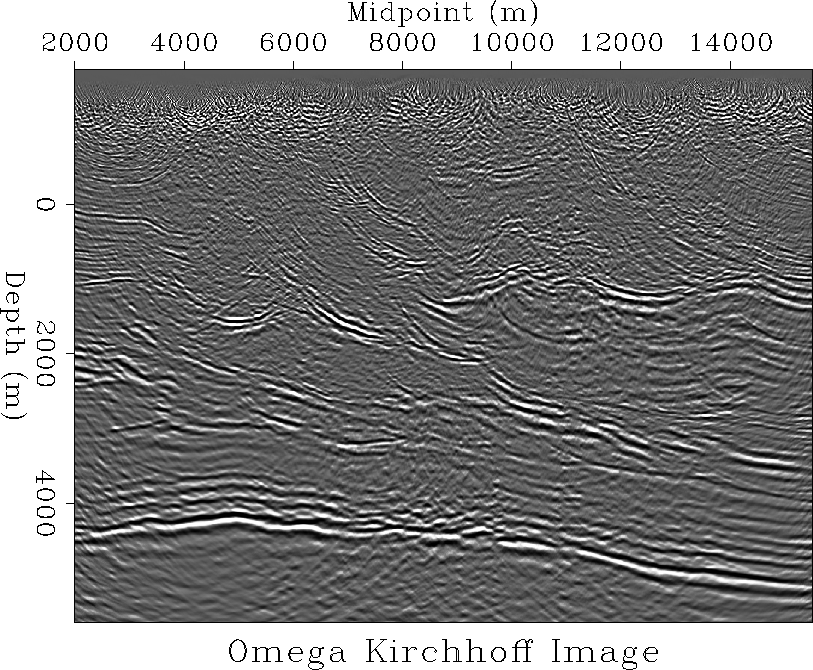




Next: Concluding Remarks
Up: Husky 2D Land Dataset
Previous: Migration Velocity Profile
Imaging tests were conducted on the topographic (WEM) and datumed
(Kirchhoff migration) datasets. Figure ![[*]](http://sepwww.stanford.edu/latex2html/cross_ref_motif.gif) presents
the results of imaging with the TopoWEM approach. Near-surface
dipping reflectors are well-imaged, as are those above and at the
basement. Note, though, that reflectors are somewhat broken up in
some locations, especially in the basement. Angle gathers (not shown
here) are generally flat; however, the presence of residual curvature
indicates velocity model inaccuracy, and suggests that additional work
to improve the currently geologically derived velocity model is
warranted.
presents
the results of imaging with the TopoWEM approach. Near-surface
dipping reflectors are well-imaged, as are those above and at the
basement. Note, though, that reflectors are somewhat broken up in
some locations, especially in the basement. Angle gathers (not shown
here) are generally flat; however, the presence of residual curvature
indicates velocity model inaccuracy, and suggests that additional work
to improve the currently geologically derived velocity model is
warranted.
TopoWEM1
Figure 6 Imaging results for
wave-equation migration from topography.




 Kirch
Kirch
Figure 7 Imaging results for
Kirchhoff migration of dataset from a flat datum.





Figure ![[*]](http://sepwww.stanford.edu/latex2html/cross_ref_motif.gif) presents the results of migrating the datumed
dataset using a Kirchhoff algorithm. Image quality is good at
mid-to-basement depths; however, near-surface reflectors
observed in the TopoWEM image are not visible. This could be due to
additional internal velocity model smoothing in the proprietary
Kirchhoff migration code, or to the failure of the vertical datuming
approximation, which distorts wave-propagation paths and defocuses the
near-surface image. (A Kirchhoff migration test
from topography has not yet been conducted.)
presents the results of migrating the datumed
dataset using a Kirchhoff algorithm. Image quality is good at
mid-to-basement depths; however, near-surface reflectors
observed in the TopoWEM image are not visible. This could be due to
additional internal velocity model smoothing in the proprietary
Kirchhoff migration code, or to the failure of the vertical datuming
approximation, which distorts wave-propagation paths and defocuses the
near-surface image. (A Kirchhoff migration test
from topography has not yet been conducted.)





Next: Concluding Remarks
Up: Husky 2D Land Dataset
Previous: Migration Velocity Profile
Stanford Exploration Project
10/31/2005
![[*]](http://sepwww.stanford.edu/latex2html/cross_ref_motif.gif) presents
the results of imaging with the TopoWEM approach. Near-surface
dipping reflectors are well-imaged, as are those above and at the
basement. Note, though, that reflectors are somewhat broken up in
some locations, especially in the basement. Angle gathers (not shown
here) are generally flat; however, the presence of residual curvature
indicates velocity model inaccuracy, and suggests that additional work
to improve the currently geologically derived velocity model is
warranted.
presents
the results of imaging with the TopoWEM approach. Near-surface
dipping reflectors are well-imaged, as are those above and at the
basement. Note, though, that reflectors are somewhat broken up in
some locations, especially in the basement. Angle gathers (not shown
here) are generally flat; however, the presence of residual curvature
indicates velocity model inaccuracy, and suggests that additional work
to improve the currently geologically derived velocity model is
warranted.

